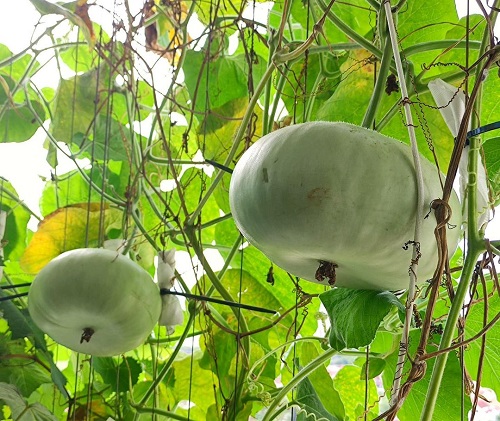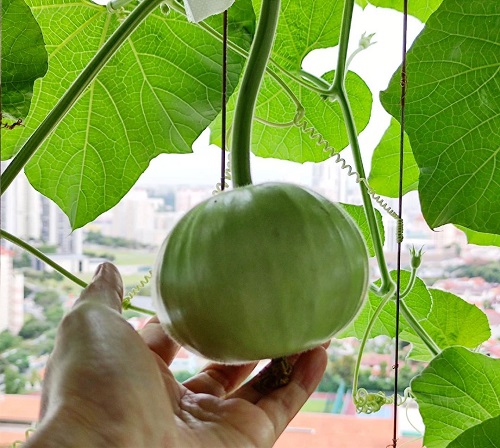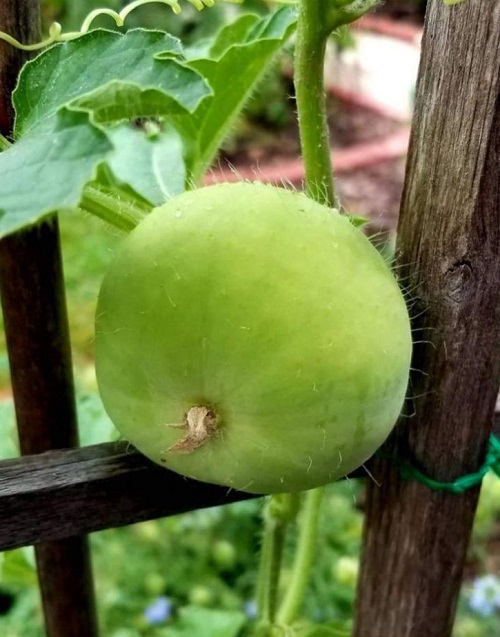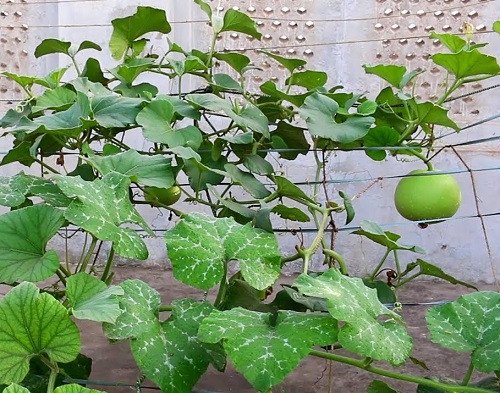Have a look at the Tinda Growing Information that will help you to grow this unique and tasty vegetable easily in the pots!
If you’re looking to grow Tinda, a popular vegetable in Indian cuisine, you’ve come to the right place. Our guide provides all the essential details on Tinda Growing Information.
Read about the 29 Best Spring Vegetables You Can Grow here
What is Tinda Vegetable?
Tinda Vegetable in English is popular as Indian round gourd, also known as Tinda (Praecitrullus fistulosus). It is a commonly cultivated vegetable in India and is known by various names in different local languages, such as Hindi, Telugu, Marathi, and Tamil.
It is also referred to as apple gourd, round melon, Indian squash, and Indian baby pumpkin. The plant grows naturally in the wild in South-East Asian countries like India, Sri Lanka, China, Nepal, and Indonesia, as well as in the warmer southern regions of Australia.
The fruits are usually oval-shaped and can grow up to 20-30 centimeters in diameter. When immature, the vegetable has a white thick flesh that is sweet. As it matures, it loses its hair and develops a waxy coating that gives it a long shelf life.
Here are the Best Round Green Vegetables to Grow in Pots and Garden
Apart from its use as a staple vegetable in Indian cuisine, the Indian round gourd has been valued for its medicinal properties since ancient times and is widely documented in Ayurvedic texts. It continues to be regarded for its numerous health benefits and is used to alleviate various illnesses of the stomach, liver, and skin, among others.
The Indian round gourd is commonly used in various Indian dishes such as kootu, curry, sabzi, and dal. Its therapeutic and remedial properties extend to its seeds and leaves as well. The roots and juice of the round gourd also have applications in skin and hair care.
Propagating Tinda
Propagating Tinda is easy to do. You will need to start with mature, ripe Tinda fruits with seeds that are still intact. Cut open the fruits and take out the seeds. Place the seeds into a bowl of warm water and allow them to soak for several hours. This will help to soften the seed coating, making it easier for the seed to germinate.
Once the seeds have been soaked, plant them directly into the soil. Make sure to plant them at least 2 inches deep and keep the soil moist but not soggy. If planting in containers, make sure there are holes in the base for proper drainage.
Once the seedlings emerge, thin them out to prevent overcrowding. When the plants are around 3-4 feet tall, they will start to develop male and female flowers.
Check out the Best Leafy Green Vegetables to Grow in Containers here
Tinda Growth Stages
- During the first 6-8 days after planting, the seeds will begin to germinate, and small sprouts will become visible.
- In the second week of germination, the first two false leaves, known as cotyledons, will appear.
- By the end of the second week, the first true leaves will emerge above the cotyledons, and the seedlings will begin to grow into small plants.
- Make sure that each plant has enough space and nutrients to grow properly; it’s important to thin out the weaker seedlings after the second week.
- To do this, use a pair of scissors to cut off any small, weak, or lagging seedlings, leaving only a single seedling in each spot.
Learn about Growing Bitter Gourd in Pots here
Tinda Container Size
If you’re growing Tinda in containers, you can use pots, grow bags, or recycled buckets. For optimal growth, choose a 12-16 inches container. To ensure proper drainage, make 4-5 drainage holes at the bottom of the container.
Learn How to Grow Round Gourd Easily here
Requirements for Growing Tinda

Sunlight
Tinda needs plenty of sunlight to grow healthy and produce a good harvest. It need at least 6-8 hours of direct sunlight per day and should be placed in a sunny spot that receives full sun for most of the day.
Partial shade may be tolerated, but the plants will not produce as much fruit in these conditions. The plants should also be rotated or moved around to ensure even exposure to the sun.
Soil
Tindas prefer a well-drained, slightly acidic soil with a pH of 6.0 to 6.5. The soil should be light and loose, with plenty of organic matter such as compost or aged manure.
Mix garden soil (20%), sand (20%), coco peat (30%), and vermicompost (30%) together for the best growth.
Learn How to Check the Soil pH at Home here
Water
During the summer months, it’s important to water the tinda plant every day to ensure that it stays healthy and hydrated. Water when the topsoil feels a little dry to the touch.
When the gourds begin to form, reduce the amount of water, as too much water can cause the gourds to split.
Here are the best ways to water plants
Tinda Plant Care

Fertilizer
Fertilizing Tinda is important for healthy growth and fruit production. The fertilizer should be applied in three stages: at planting, when the plants start flowering, and when the fruits start to appear.
For the best results, use a balanced fertilizer with equal amounts of nitrogen, phosphorus, and potassium. It’s also a good idea to add a few extra teaspoons of magnesium sulfate or Epsom salts to the mixture for increased magnesium content.
Here are the Best DIY Potassium Fertilizer Recipes
Apply the fertilizer once or twice a month, depending on the size of the Tinda plants. For larger plants, use a higher concentration of fertilizer and apply it more frequently.
Trellis
To accommodate the aggressive climbing nature of Tinda plants, it’s crucial to provide ample space for their growth.
Building a sturdy trellis support is recommended, which should be at least 5-6 feet high. You can construct the support using locally available materials like pipes, bamboo, ropes, wires, and other suitable options.
Here are the Best DIY Trellis for Plants Ideas (Indoors and Outdoors)
Pests and Diseases
Pests:
1. Spotted Cucumber Beetle
2. Squash Bug
3. Striped Cucumber Beetle
4. Aphids
5. Squash Vine Borer
Diseases:
1. Powdery Mildew
2. Downy Mildew
3. Cucumber Mosaic Virus
4. Alternaria Leaf Blight
5. Bacterial Wilt
It is important to remain vigilant for early signs of insect or fungal infections, as well as any other infections that may affect your Tinda plants. If any symptoms are detected, appropriate medicines should be sprayed immediately to prevent the spread of the disease.
Learn about the Types of Common Pests in Your Garden & How to Get Rid of Them here
Harvesting Tinda
To begin, wait until Tinda has reached full maturity and its skin has hardened. Then, use a pair of gardening shears to cut the stem of the Tinda and remove it from the vine.
Place the harvested Tinda in a cool, dry place to cure for at least two weeks. Once the skin of the Tinda is hard, and the stem easily pulls off, it is ready to be used.
Benefits of Tinda
1. Aids in Weight Loss
Tinda is low in calories and high in water content and dietary fiber. It can help reduce cravings, keep you fuller for longer, and support fat burning, making it a valuable addition to a weight loss diet.
2. Maintains Cardiovascular Health
Tinda is a great food for maintaining heart health, as it is low in fat and cholesterol and helps improve blood circulation in the heart. Including Tinda in your diet can help keep your cardiac muscles functioning optimally and support overall cardiovascular health.
3. Improves Digestion
It is a rich source of fiber, which can help prevent constipation, bloating, and stomach cramps. The laxative properties of Tinda can help regulate bowel movements and promote a healthy digestive system.
4. Promotes Eye Health
The high levels of Vitamin A and carotenoid antioxidants, such as lutein and zeaxanthin, found in Tinda can help improve and maintain healthy eyesight. These antioxidants protect the retina and other vital eye structures.



